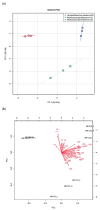Manufacture of a Potential Antifungal Ingredient Using Lactic Acid Bacteria from Dry-Cured Sausages
- PMID: 37048247
- PMCID: PMC10093346
- DOI: 10.3390/foods12071427
Manufacture of a Potential Antifungal Ingredient Using Lactic Acid Bacteria from Dry-Cured Sausages
Abstract
The growing interest in functional foods has fueled the hunt for novel lactic acid bacteria (LAB) found in natural sources such as fermented foods. Thus, the aims of this study were to isolate, identify, characterize, and quantify LAB's antifungal activity and formulate an ingredient for meat product applications. The overlay method performed a logical initial screening by assessing isolated bacteria's antifungal activity in vitro. Next, the antifungal activity of the fermented bacteria-free supernatants (BFS) was evaluated by agar diffusion assay against six toxigenic fungi. Subsequently, the antifungal activity of the most antifungal BFS was quantified using the microdilution method in 96-well microplates. The meat broth that showed higher antifungal activity was selected to elaborate on an ingredient to be applied to meat products. Finally, antifungal compounds such as organic acids, phenolic acids, and volatile organic compounds were identified in the chosen-fermented meat broth. The most promising biological candidates belonged to the Lactiplantibacillus plantarum and Pediococcus pentosaceus. P. pentosaceus C15 distinguished from other bacteria by the production of antifungal compounds such as nonanoic acid and phenyl ethyl alcohol, as well as the higher production of lactic and acetic acid.
Keywords: Lactiplantibacillus plantarum; Pediococcus pentosaceus; antifungal activity; organic acids; phenolic acids; volatile organic compounds.
Conflict of interest statement
The authors declare no conflict of interest.
Figures




Similar articles
-
Preparation of Sourdoughs Fermented with Isolated Lactic Acid Bacteria and Characterization of Their Antifungal Properties.Foods. 2023 Feb 4;12(4):686. doi: 10.3390/foods12040686. Foods. 2023. PMID: 36832761 Free PMC article.
-
Suitability of pitaya fruit fermented by sourdough LAB strains for bread making: its impact on dough physicochemical, rheo-fermentation properties and antioxidant, antifungal and quality performance of bread.Heliyon. 2021 Oct 29;7(11):e08290. doi: 10.1016/j.heliyon.2021.e08290. eCollection 2021 Nov. Heliyon. 2021. PMID: 34778581 Free PMC article.
-
Dry Fermented Sausages with Total Replacement of Fat by Extra Virgin Olive Oil Emulsion and Indigenous Lactic Acid Bacteria.Food Technol Biotechnol. 2021 Sep;59(3):267-281. doi: 10.17113/ftb.59.03.21.7114. Food Technol Biotechnol. 2021. PMID: 34759759 Free PMC article.
-
Antibiotic resistance of lactic acid bacteria isolated from dry-fermented sausages.Int J Food Microbiol. 2015 Nov 6;212:76-88. doi: 10.1016/j.ijfoodmicro.2015.04.035. Epub 2015 Apr 29. Int J Food Microbiol. 2015. PMID: 26002560 Review.
-
The impacts of antimicrobial and antifungal activity of cell-free supernatants from lactic acid bacteria in vitro and foods.Compr Rev Food Sci Food Saf. 2022 Jan;21(1):604-641. doi: 10.1111/1541-4337.12872. Epub 2021 Dec 14. Compr Rev Food Sci Food Saf. 2022. PMID: 34907656 Review.
Cited by
-
Biocontrol of Pathogen Microorganisms in Ripened Foods of Animal Origin.Microorganisms. 2023 Jun 14;11(6):1578. doi: 10.3390/microorganisms11061578. Microorganisms. 2023. PMID: 37375080 Free PMC article. Review.
-
Lactic acid bacteria: beyond fermentation to bio-protection against fungal spoilage and mycotoxins in food systems.Front Microbiol. 2025 Jun 30;16:1580670. doi: 10.3389/fmicb.2025.1580670. eCollection 2025. Front Microbiol. 2025. PMID: 40661977 Free PMC article. Review.
-
Perspectives on the Probiotic Potential of Indigenous Moulds and Yeasts in Dry-Fermented Sausages.Microorganisms. 2023 Jul 4;11(7):1746. doi: 10.3390/microorganisms11071746. Microorganisms. 2023. PMID: 37512918 Free PMC article. Review.
-
In vitro safety and functional characterization of the novel Bacillus coagulans strain CGI314.Front Microbiol. 2024 Jan 10;14:1302480. doi: 10.3389/fmicb.2023.1302480. eCollection 2023. Front Microbiol. 2024. PMID: 38274758 Free PMC article.
-
Exploring the Potential of Postbiotics for Food Safety and Human Health Improvement.J Nutr Metab. 2024 Aug 6;2024:1868161. doi: 10.1155/2024/1868161. eCollection 2024. J Nutr Metab. 2024. PMID: 39139215 Free PMC article. Review.
References
-
- Manassi C.F., de Souza S.S., de Souza Hassemer G., Sartor S., Lima C.M.G., Miotto M., De Dea Lindner J., Rezzadori K., Pimentel T.C., Ramos G.L.D.P.A., et al. Functional meat products: Trends in pro-, pre-, syn-, para- and post-biotic use. Food Res. Int. 2022;154:111035. doi: 10.1016/j.foodres.2022.111035. - DOI - PubMed
-
- Whitnall T., Pitts N. Global trends in meat consumption. Agric. Commod. 2019;9:96–99.
-
- Rodríguez A., Rodríguez M., Martín A., Nuñez F., Córdoba J.J. Evaluation of hazard of aflatoxin B1, ochratoxin A and patulin production in dry-cured ham and early detection of producing moulds by qPCR. Food Control. 2012;27:118–126. doi: 10.1016/j.foodcont.2012.03.009. - DOI
Grants and funding
LinkOut - more resources
Full Text Sources
Miscellaneous

